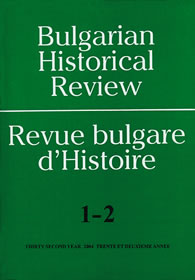Населението на Сливенски санджак - инициатор за ежегодно изложение на изделия на местната промишленост и занаяти - 1869 г.
The Population of the Sanjac of Sliven – Initiator of Annual Fairs of Manufacturing Products and Handicraft Articles
Author(s): Ognyana Mazhdrakova-ChavdarovaSubject(s): History
Published by: Институт за исторически изследвания - Българска академия на науките
Summary/Abstract: During the 1860s the Sanjac of Sliven showed up as one of the most intensively developing regions of European Turkey in which the Bulgarian productive population was of primary significance. Capitalist manufacturing and commercial structures of a new type were established in the woolen cloth industry. Several initiatives aiming at economic progress emerged from among the circles of enterprising Bulgarian merchants and industrialists, connected with the European market and interested in the protectionist policy of the government. Such an initiative was the statement („Mazbata“) sent by the population of the Sanjac of Sliven in March 1869 to the Vilayet administration asking for permission of an annual fair of homespun woolen cloth and leather products, arms, etc. to be organized in Sliven. The Regional Council of the Vilayet of Adrianople hold side with the request of the Sliven population. The record of the session was sealed by seventeen Vilayet officials and five Bulgarians representing the population of Sliven, Adrianople, Kazanlak and Vassiliko (present day Tsarevo). Most probably the idea came from the notables of Sliven who were members of both the Bulgarian community and the local administrative council (mejlis). The Ministry of the Interior in Istanbul approved the initiative but decided the place of the fair to be the Vilayet centre of Adrianople instead of Sliven. According to the author the discussions about this proposal gave impetus to an Emperor’s order announced in Dunav and Dunavski Vilayet newspapers for the organization of a fair of handicraft articles, manufacturing and agricultural products as early as in the autumn of 1870. In conclusion the author points out the coincidence of interests of some business circles of the Bulgarian bourgeoisie with the ideas of the reformist minded representatives of the Ottoman state – an important but insufficiently used circumstance with a view to the economic progress and modernization processes in economics.
Journal: Bulgarian Historical Review / Revue Bulgare d'Histoire
- Issue Year: 2006
- Issue No: 1-2
- Page Range: 332-347
- Page Count: 16
- Language: Bulgarian
- Content File-PDF

